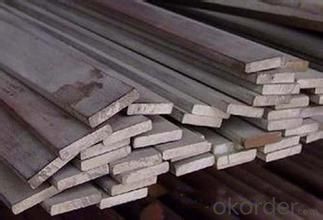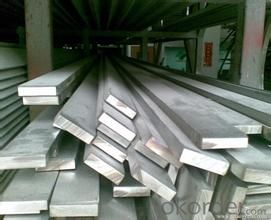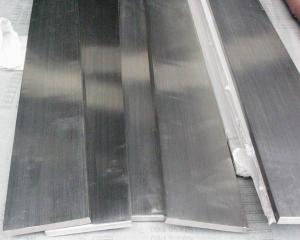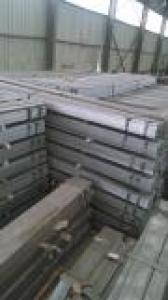Hot Rolled Narrow Flat Steel 20mm*3mm*6m
- Loading Port:
- Tianjin
- Payment Terms:
- TT or LC
- Min Order Qty:
- 25 m.t.
- Supply Capability:
- 10000 m.t./month
OKorder Service Pledge
OKorder Financial Service
You Might Also Like
Product Description:
OKorder is offering Hot Rolled Narrow Flat Steel 20mm*3mm*6m at great prices with worldwide shipping. Our supplier is a world-class manufacturer of steel, with our products utilized the world over. OKorder annually supplies products to European, North American and Asian markets. We provide quotations within 24 hours of receiving an inquiry and guarantee competitive prices.
Product Applications:
Hot Rolled Narrow Flat Steel 20mm*3mm*6m are ideal for structural applications and are widely used in the construction of buildings and bridges, and the manufacturing, petrochemical, and transportation industries.
Product Advantages:
OKorder's Hot Rolled Narrow Flat Steel 20mm*3mm*6m are durable, strong, and resist corrosion.
Product Specifications:
Manufacture: Hot rolled
Grade: Q195 – 235
Certificates: ISO, SGS, BV, CIQ
Length: 6m – 12m, as per customer request
FAQ:
Q1: Why buy Materials & Equipment from OKorder.com?
A1: All products offered byOKorder.com are carefully selected from China's most reliable manufacturing enterprises. Through its ISO certifications, OKorder.com adheres to the highest standards and a commitment to supply chain safety and customer satisfaction.
Q2: How do we guarantee the quality of our products?
A2: We have established an advanced quality management system which conducts strict quality tests at every step, from raw materials to the final product. At the same time, we provide extensive follow-up service assurances as required.
Q3: How soon can we receive the product after purchase?
A3: Within three days of placing an order, we will begin production. The specific shipping date is dependent upon international and government factors, but is typically 7 to 10 workdays.
Q4: What makes stainless steel stainless?
A4: Stainless steel must contain at least 10.5 % chromium. It is this element that reacts with the oxygen in the air to form a complex chrome-oxide surface layer that is invisible but strong enough to prevent further oxygen from "staining" (rusting) the surface. Higher levels of chromium and the addition of other alloying elements such as nickel and molybdenum enhance this surface layer and improve the corrosion resistance of the stainless material.
Q5: Can stainless steel rust?
A5: Stainless does not "rust" as you think of regular steel rusting with a red oxide on the surface that flakes off. If you see red rust it is probably due to some iron particles that have contaminated the surface of the stainless steel and it is these iron particles that are rusting. Look at the source of the rusting and see if you can remove it from the surface.
Images:


- Q:What are the different types of edge finishes available for steel flat bars?
- Steel flat bars can have various edge finishes to meet different aesthetic and functional needs. Here are some of the most common options: 1. Square Edge: The edges of the flat bars are kept square, making it a simple and basic finish. It is often used for structural purposes or when appearance is not a significant factor. 2. Rounded Edge: Also referred to as a radius edge, this finish involves smoothing out the sharp edges of the flat bar. It enhances visual appeal and safety by reducing the risk of injuries from sharp edges. 3. Beveled Edge: This finish involves cutting the edges of the flat bar at a specific angle, usually 45 degrees. It is commonly used when joining two flat bars at a specific angle to create a clean and precise joint. 4. Rolled Edge: This type of finish requires rolling the edges of the flat bar to create a curved or rolled appearance. Rolled edges are often used for decorative purposes, adding a unique and stylish touch to the flat bar. 5. Serrated Edge: A serrated edge finish features small notches or teeth along the edges of the flat bar. It is commonly used in applications where enhanced grip or traction is necessary, such as grating or flooring. 6. Chamfered Edge: Instead of only beveling the ends, chamfering involves cutting a beveled edge along the entire length of the flat bar. This finish is frequently used to remove sharp corners and make handling the flat bar easier. These examples showcase the variety of edge finishes available for steel flat bars. The choice of finish depends on factors such as the intended use, aesthetic preferences, safety requirements, and cost considerations.
- Q:How do I choose the right size of steel flat bar for my project?
- To choose the right size of steel flat bar for your project, you should consider factors such as the load-bearing capacity required, the dimensions of the project, and any specific design requirements. It is essential to consult with a structural engineer or an expert in steel fabrication to ensure that the chosen size can adequately support the intended weight and meet the project's specifications.
- Q:Can steel flat bars be used in the manufacturing of fencing or gates?
- Absolutely, steel flat bars are ideal for incorporating into the production process of fencing or gates. Possessing remarkable strength and durability, steel flat bars emerge as an exceptional option for crafting robust fences and gates capable of enduring diverse weather conditions and ensuring security. By welding or bolting these bars together, a stable and enduring framework can be established, guaranteeing stability and durability. Moreover, steel flat bars can be effortlessly manipulated and tailored to meet precise design specifications, enabling the development of one-of-a-kind fences and gates that are visually appealing.
- Q:Can steel flat bars be used for manufacturing tools?
- Yes, steel flat bars can be used for manufacturing tools. Steel is known for its strength and durability, making it an ideal material for tool production. Steel flat bars can be easily shaped and machined to create various types of tools, such as wrenches, chisels, and scrapers. Additionally, steel's resistance to wear and corrosion ensures that the tools made from steel flat bars will have a longer lifespan and maintain their effectiveness over time.
- Q:Are steel flat bars prone to warping or bending?
- Steel flat bars are generally known for their strength and durability, making them less prone to warping or bending compared to other materials. However, it is important to note that steel flat bars can still warp or bend under certain circumstances. Factors such as excessive heat, overloading, inappropriate storage, or inadequate structural support can contribute to the deformation of steel flat bars. To minimize the risk of warping or bending, it is recommended to use high-quality steel flat bars, ensure proper installation and structural support, and avoid subjecting them to extreme conditions or excessive loads.
- Q:Can steel flat bars be used for shelving or storage systems?
- Yes, steel flat bars can indeed be used for shelving or storage systems. Steel flat bars are known for their strength and durability, making them an excellent choice for heavy-duty applications such as shelving and storage systems. They can provide reliable support for storing heavy items and can withstand significant weight without bending or warping. Additionally, steel flat bars can be easily welded or bolted together to create custom shelving configurations to suit specific storage needs. Their resistance to corrosion also ensures a long-lasting and low-maintenance solution for organizing and storing various items.
- Q:Can steel flat bars be heat treated?
- Steel flat bars can indeed undergo heat treatment. Heat treatment is a useful technique for modifying the physical and mechanical properties of steel by subjecting it to specific heating and cooling cycles. It is a widely employed process for enhancing the hardness, strength, and toughness of steel flat bars. Depending on the desired results, heat treatment can be carried out through various methods, including annealing, normalizing, quenching, and tempering. Each of these methods involves heating the steel to a specific temperature and then carefully controlling the cooling rate. Heat treatment finds extensive application in industries such as manufacturing, construction, and automotive to improve the performance and durability of steel flat bars.
- Q:Are steel flat bars susceptible to rust?
- Yes, steel flat bars are susceptible to rust. Steel, by nature, is an alloy made primarily of iron and carbon, which makes it prone to oxidation when exposed to moisture and oxygen. When steel flat bars are exposed to these elements, a chemical reaction occurs, resulting in the formation of iron oxide, commonly known as rust. However, the susceptibility to rust can be reduced through various methods such as applying protective coatings, galvanizing, or using stainless steel, which has a higher resistance to rust due to the addition of chromium. Regular maintenance and proper storage can also help prevent or minimize the occurrence of rust on steel flat bars.
- Q:Are steel flat bars prone to warping?
- Steel flat bars can be susceptible to warping in specific circumstances. Warping may arise from internal stresses within the material, uneven cooling during manufacturing, or excessive heat during welding or other fabrication procedures. Furthermore, inadequate storage or handling can contribute to warping. However, the degree of warping hinges on factors including the steel type, thickness, and particular application. To mitigate the likelihood of warping in steel flat bars, it is crucial to adhere to appropriate guidelines for storage, handling, and fabrication.
- Q:How is a steel flat bar different from other types of steel bars?
- A steel flat bar, as the name suggests, is characterized by its flat and rectangular shape. Unlike other types of steel bars such as round or square bars, which have circular or square cross-sections respectively, a flat bar has a wide and flat surface area. This unique shape makes it ideal for applications where a strong and sturdy support or structural element is required, such as in construction, manufacturing, or DIY projects.
1. Manufacturer Overview |
|
|---|---|
| Location | |
| Year Established | |
| Annual Output Value | |
| Main Markets | |
| Company Certifications | |
2. Manufacturer Certificates |
|
|---|---|
| a) Certification Name | |
| Range | |
| Reference | |
| Validity Period | |
3. Manufacturer Capability |
|
|---|---|
| a)Trade Capacity | |
| Nearest Port | |
| Export Percentage | |
| No.of Employees in Trade Department | |
| Language Spoken: | |
| b)Factory Information | |
| Factory Size: | |
| No. of Production Lines | |
| Contract Manufacturing | |
| Product Price Range | |
Send your message to us
Hot Rolled Narrow Flat Steel 20mm*3mm*6m
- Loading Port:
- Tianjin
- Payment Terms:
- TT or LC
- Min Order Qty:
- 25 m.t.
- Supply Capability:
- 10000 m.t./month
OKorder Service Pledge
OKorder Financial Service
Similar products
New products
Hot products
Related keywords





























